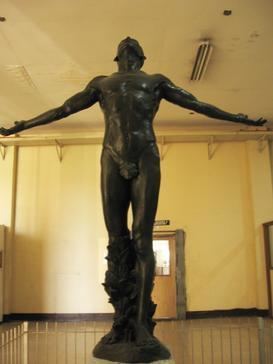 | ||
The Oblation (Filipino: Pahinungod, Oblasyon) is a concrete statue by Filipino artist Guillermo E. Tolentino which serves as the iconic symbol of the University of the Philippines. It depicts a man facing upward with arms outstretched, symbolizing selfless offering of oneself to his country.
Contents
History
The idea for the Oblation was first conceived during the presidency of Rafael Palma, who was the one to commission Tolentino to make the sculpture. Palma requested that the statue would be based on the second verse of Rizal's Mi Ultimo Adios;
The concrete sculpture painted to look like bronze, measures 3.5 meters in height, symbolizing the 333 years of Spanish rule in the Philippines. The sculpture is replete with references of selfless dedication and service to the nation, and as Tolentino himself describes it;
Originally, the statue was completely naked, but, as morality was prevailing at that time, it was modified by former U.P. President Jorge Bocobo, 4th President of UP, with the addition of a fig leaf to cover the genitals. The sculpture was funded by the U.P. students of 1935-1936, and was presided by Potenciano Illusorio and Jose B. Laurel, Jr., presidents of the student council during the first and second semester respectively and was dedicated on March 1939 at the University's Manila campus where it stayed until February 1949, when the main administrative offices of the university moved to the new Diliman campus in Quezon City. The transfer of the Oblation to its new home served as the highlight of the move from Manila, which is historically referred to as the Exodus. The sculpture in front of the Quezon Hall at Diliman was installed facing west, purportedly a tribute to the American roots of the University. Today, that sculpture is only a bronze replica (which was recast from the original in Italy in 1950, under the supervision of Tolentino himself) dedicated on U.P.'s Golden Jubilee on November 29, 1958. The original sculpture is being kept at the Main Library (Gonzalez Hall), the former site of the U.P. College of Fine Arts.The statue was created by Guillermo E. Tolentino.
Several replicas of the Oblation were made for campuses of the University of the Philippines, some by National Artist Napoleon Abueva. The Oblation at the U.P. Visayas campus in Iloilo City was made by Professor Anastacio Caedo. 2005 National Artist nominee Glenn Bautista [4][5], likewise, did his celebrated version of the Oblation in pen and ink as part of his schoolplates at the U.P. College of Fine Art under Professor Rebillon. The sculpture was registered at the Intellectual Property Office in the year 2004. Being the main symbol of the university, the Oblation is the centerpiece of many U.P.-related logos, like those of the Philippine Collegian and other official student publications, the U.P. Cooperative, and the U.P. Centennial emblem.
The U.P.O.U. Oblation sculpture is unique for its ribbon-like flag swirling around the pedestal and the replica of Guillermo Tolentino's U.P. Oblation. This gives an effect of the flag lifting the Oblation into greater heights and rendering it the boundless reach that is symbolic of U.P.O.U.'s prime objective of widening access to U.P. quality education. Completed in 2005, it was designed and executed by University Artist and U.P.O.U. Chancellor Dr. Grace J. Alfonso.
Locations
As the primary icon of the University of the Philippines, oblation statues are located in most campuses of constituent universities. Oblation statues can be found at[may be incomplete]:
- UP Diliman - Gonzales Hall, Diliman Campus [original]
- UP Diliman - Oblation Plaza, Diliman Campus
- UP Diliman - UP Clarkfield, Pampanga Extension Campus
- UP Diliman - Bonifacio Global City (Graduate school in Taguig)
- UP Manila - Rizal Hall, Manila Campus
- UP Manila - Palo, Leyte Extension Campus
- UP Manila - Koronadal City, South Cotabato Extension Campus
- UP Manila - Baler, Aurora Extension Campus
- UP Manila - Oblation Plaza, Philippine General Hospital, Manila [the "Centennial Oblation"]
- UP Baguio - Oblation Grounds
- UP Baguio - Office of the College Secretary, College of Arts and Communication
- UP Los Baños - Oblation Park
- UP Visayas - Iloilo Campus
- UP Visayas - Miag-ao Campus
- UP Visayas - Tacloban College (UPVTC)
- UP Mindanao - Oblation Plaza
- UP Open University - UPOU Oblation Plaza, Los Baños, Laguna
- UP Cebu - Oblation Square
Model
The identity of the person who served as the model of the sculpture has been long been the subject of speculation.
University literature records the names of two persons who served as a model for the oblation: Tolentino's student assistant Anastacio Caedo, and Caedo's brother-in-law, Virgilio Raymundo. Specifically, Tolentino used Caedo's physique and Raymundo's proportion for reference. Caedo would later become a professor of Fine Arts in the University himself, succeeding the deceased Tolentino. His works now form part of the University Collection, and one of his monuments of Jose Rizal for the German government was installed in an eponymous Park in Wilhelmsfeld, Germany.
A persistent urban legend has it, however, that director-actor Fernando Poe, Sr. was the model, as he was a student at the University at the time the Oblation was being made. Other names that have said to pose for the sculpture include a friend of Tolentino, Ferdinand Glenn Gagarin and fireman June Villanueva.
Oblation Run
The Oblation Run at University of the Philippines Diliman is an annual tradition inspired by the Oblation done by the members of the Alpha Phi Omega, one of the prominent and influential U.P. fraternities. Members of the fraternity run around the campus naked (a concept known as streaking) to protest their sentiments about a current political or economic situation.
"100 Nudes/100 Years"
Inspired by the U.P. Oblation, the University of the Philippines Alumni Association (U.P.A.A.) launched an art exhibit, "100 Nudes/100 Years" featuring the works of nine (9) U.P. alumni national artists.
